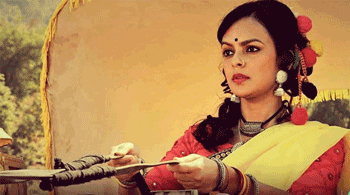Review: The Sholay Girl
By Deneb Sumbul | Here and Now | Movies | Published 6 years ago
A film titled The Sholay Girl, was recently released, and it began with a live shot from the 1975 action adventure blockbuster, Sholay. However, this film is not about Hema Malini, the hugely popular heroine of the first film, as one might have expected, from the title, but in fact about the incredible stunt-woman who played her body double in that same film. Released on March 8 to coincide with International Women’s Day, The Sholay Girl is a period biopic on India’s first officially acknowledged stunt-woman, Reshma Pathan, who entered the vocation as a young teenager. Born with an indomitable spirit, neither her age nor her humble, conservative Muslim background deterred her from making a career in a profession dominated by men in the late 1960s.
The Sholay Girl begins with a take on the memorable action-packed tonga chase of the original film, in which Hema Malini in the role of tonga-girl Basanti, is surrounded by goons. She shouts “Chal Dhanno,” leaps on her horse cart and races to outrun them. In real life what happened during that fateful chase was that the tonga hits a rock, somersaulted and landed on top of Reshma, who was playing Malini’s stunt double. Resultantly, the film shooting ceased immediately and the camera crew rushed to lift the cart off Reshma, whose legs were pinned under. She was rushed to the hospital to be attended to for injuries that could have crippled her. In The Sholay Girl that real life episode is enacted in reel life with Bidita Bag playing the lead.

Bidita Bag plays the inimitable Reshma Pathan, Indian cinema’s first ever stuntwoman.
The film then flashbacks to 1962, as Reshma recounts her family’s days of hunger and hardships living in Pydhonie in south Mumbai. In those days an imposed rice ban had led to rice smuggling in which her burqa-clad mother was also involved, and was subsequently caught along with other families. This was followed by her father’s hospitalisation, which rendered him partially handicapped. Not having a choice, her mother turned to Reshma, the eldest child still at a tender age, to care for her younger siblings.
Fast-forward to 1968; Reshma, by now a 14-year-old veritable tomboy, demonstrates assorted physically demanding antics in a public square to earn a few coins, which her younger siblings collect from onlookers. One day, an action choreographer, who is also a family friend, observes Reshma’s athletic prowess and accurately surmises her natural talent. He tries to convince Reshma’s father to allow her to work in the film industry. Enraged at the idea, her father berates and beats her despite being partially handicapped, but Reshma’s indomitable spirit prevails, and she manages to bring him around to becoming the family’s sole breadwinner, embarking on a road until then barely travelled.

The lead of The Sholay Girl with Reshma Pathan.
At the film studios, Reshma pulls off a perfect stunt on the very first take. The same stunt had repeatedly been attempted by a stunt-man dressed as a woman, but without much success. And thereafter, there is no turning back for Reshma. This at a time when men body-doubled as women, and earned Reshma the ire of several men threatened by her prowess. Reshma was routinely called as a stunt double for actresses such as Meena Kumari, Saira Banu, Hema Malini, Sri Devi, Dimple Kapadia and Meenakshi Seshadri.
It was the iconic action sequence in Sholay that brought Reshma fame in her own right. And following that, no matter how dangerous the stunt, she never refused, often returning home battered and bruised with cuts, stitches and bandages. All the more creditable given that at the time no safety concerns or measures existed in the film industry to protect the life and limb of stuntmen. Her courage can be gauged by the fact that off- screen too, Reshma would take on neighbourhood goons, who made the mistake of casting aspersions on her character, with the same fervour that she did on-screen.
To prepare herself for the physically demanding role of Reshma, Bidita Bag took martial arts training and watched the tonga scene innumerable times to master the opening scene of the film. Aditya Sarpotdar has directed the period drama film as an inspirational story, but one came away with a sense that the director had downplayed the exploitative nature of the film industry which Reshma worked in for three decades, especially since stuntmen and junior artists were paid very poorly.
Towards the end of the film, we get a glimpse of the real adrenaline-loving Reshma, now in her late fifties, who despite her age does not miss out an opportunity to play a body double. Incidentally, in her personal life she rides a Honda Activa bike – a birthday gift from her children.
The writer is working with the Newsline as Assistant Editor, she is a documentary filmmaker and activist.


